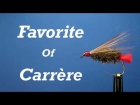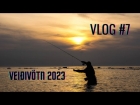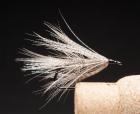Book review: Modern Streamers for Trophy Trout, Second opinion
This is a book that deliberately sets out to help the reader achieve a goal, which few of us actually admit we have: to catch BIG fish!
Modern Streamers for Trophy Trout is quite systematic, and guides the reader through a natural evolution in understanding the advice to come. This is done by introducing the basics: behavior, food selection, and habitats of larger trout, then discuss tactics and in the end show you the right flies.
After having introduced the basics Linsenmann and Galloup make sure you understand the methods needed. These encompass some basic methods of casting larger flies and the more detailed methods of stripping and fishing them. The authors have some really interesting observations here, and their tactics and stripping patterns are different and very much worth paying attention to.
This section also details the fight, landing and release of larger fish. Experienced fishers might find this too banal, but the book would not be complete without. And honestly; even some of the most experienced of us have no substantial experience with really large fish and the hardship these can bring. I personally would like to have a lot more "field experience' in this area...
By now the reader is about half way through the book, and ready to enter what I consider the really interesting part: fly choice, fly design and fly patterns.
The first chapter is convincingly called "Today's Most Effective Patterns". If that does not wet your appetite nothing will. This is where the gold lies. Again we are talking a structured way of treating the subject, and the flies are clearly categorized in four classes: muddlers, baitfish, crayfish & leeches and attractors. There are 6-8 patterns in each group - most of them new ones.
The groups are covered individually in a row of chapters where the argumentation for their design is presented. Older and well known flies are mentioned, but most are not covered in detail. The color schemes are discussed and altogether I find these chapters very central in the book. Combine these large flies with the jerk-strip and a sinking line, and I am sure you will produce fish larger than your average.
The last bit of the book is an individual materials list with an accompanying short pattern and tying description. The B/W pictures in this section are disappointing and strangely treated with a harsh shadow, but luckily the flies are all depicted in nice and clear color plates in the preceding section.
The illustrations throughout the book are B/W drawings and photos of a very fine quality, and in the first part you will find an inset of color photos clearly documenting that the described flies and tactics really do work.
All through the book the authors attack the subject with weight (excuse the pun) and clearly demonstrate that they have experience and that their methods work. All is illustrated in text and pictures with clear and entertaining evidence.
The flies and methods are different if not radical, and will probably be looked upon by many as too much meat-and-potatoes fishing. But if you are not finicky about using heavy flies, sinking lines and some quite energized and aggressive methods, I am sure that this book can put you into more large fish than you ever dreamed possible.
Read more about why you should register.
More content from the front page
Since you got this far …
… I have a small favor to ask.
Long story short
Support the Global FlyFisher through several different channels, including PayPal.
Long story longer
The Global FlyFisher has been online since the mid-90's and has been free to access for everybody since day one – and will stay free for as long as I run it.
But that doesn't mean that it's free to run.
It costs money to drive a large site like this.
See more details about what you can do to help in this blog post.



















































